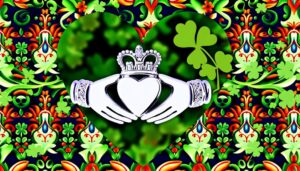What Does the Star of David Symbolize in Judaism and Its Meaning?
In Judaism, symbols hold profound spiritual and historical significance. The Star of David, an emblem of Jewish identity, symbolizes continuity and faith, traditionally linked to King David.
The Menorah, an ancient candelabrum, represents wisdom and divine guidance, notably used during Hanukkah. The Mezuzah, fixed to doorposts, containing Torah verses, serves as a perpetual reminder of God's presence.
The Chai Symbol, meaning 'life,' underscores the sanctity and ethical importance of life. The Hamsa Hand, a protective amulet, invokes divine safeguarding.
Each symbol deeply intertwines with Jewish traditions and values, inviting a richer understanding of Jewish culture and spirituality.
Key Takeaways
- The Star of David is an emblem of Judaism, symbolizing Jewish identity and continuity.
- The Menorah represents wisdom, enlightenment, and guidance, with historical significance in Jewish worship.
- The Mezuzah, affixed to doorposts, contains Torah verses, serving as a reminder of God's presence.
- The Chai symbol translates to 'life' and emphasizes the value of ethical living.
- The Hamsa Hand is an emblem of protection and blessing, originating from ancient Middle Eastern traditions.
The Star of David
The Star of David, frequently recognized as a prominent emblem of Judaism, holds profound spiritual and historical significance. Comprising two interlocking triangles, it symbolizes the interconnectedness of divine and earthly domains.
Historically, it has been associated with King David and his shield, representing Jewish identity and continuity. Spiritually, it conveys the harmony of creation, with its six points signifying God's rule over the universe in all six directions: north, south, east, west, up, and down.
The hexagram's geometric symmetry reflects the Jewish pursuit of balance and unity. This emblem, known in Hebrew as the Magen David, continues to be a powerful symbol of faith, resilience, and the Jewish people's enduring covenant with the Divine.
The Menorah
The Menorah stands as one of the most ancient and revered symbols in Judaism, embodying profound historical significance from its origins in the Tabernacle and later the Temple in Jerusalem.
Its ritualistic use during Hanukkah and other ceremonies underscores its enduring presence in Jewish worship and tradition.
Additionally, the Menorah's seven branches symbolize the divine light spreading throughout the world, representing wisdom, enlightenment, and spiritual guidance.
Historical Significance
Rooted deeply in Jewish tradition and history, the Menorah stands as a profound symbol of resilience and divine illumination. Emerging from the ancient Temple in Jerusalem, the Menorah's seven branches symbolize the universal presence of divine light and wisdom.
Its historical significance is multifaceted and encompasses various dimensions:
- Divine Covenant: Represents the eternal covenant between God and the Jewish people.
- Temple Service: Integral to the daily rituals performed in the Holy Temple.
- Miracle of Hanukkah: Commemorates the miraculous event of the oil lasting eight days.
- Cultural Identity: Serves as an enduring emblem of Jewish identity and continuity.
The Menorah not only illuminates physical spaces but also casts the light of spiritual endurance and hope across generations.
Ritualistic Use
In its ritualistic capacity, the Menorah serves as a profound conduit for spiritual reflection and communal worship within Jewish practice. Central to the Hanukkah celebration, the lighting of the Menorah's eight branches commemorates the miraculous oil that burned for eight days in the rededicated Second Temple.
This act of illumination is imbued with deep spiritual significance, connecting participants to their faith and heritage. The Menorah's radiant glow symbolizes divine presence and guidance, fostering an atmosphere of reverence and unity within the community.
Each night of Hanukkah, the progressive lighting of candles invites contemplation on themes of perseverance, faith, and divine intervention, reinforcing the enduring values central to Jewish life and worship.
Symbolic Representation
Beyond its ritualistic use, the Menorah stands as a potent symbol of Jewish identity and divine enlightenment, reflecting profound theological and historical significance.
The seven-branched candelabrum, originally designed for the ancient Tabernacle, symbolizes the light of God's wisdom illuminating the world. It represents the burning bush encountered by Moses, signifying eternal flame and divine presence. The Menorah also commemorates the miracle of the oil during the rededication of the Second Temple, evoking themes of faith and resilience.
- Divine Wisdom: Symbolizes God's illumination and knowledge.
- Historical Continuity: Links Jewish heritage from the Tabernacle to modern times.
- Divine Presence: Represents the eternal flame and God's perpetual presence.
- Faith and Resilience: Commemorates the miracle of the oil, symbolizing enduring faith.
The Mezuzah
Often affixed to the doorposts of Jewish homes, the mezuzah serves as a profound symbol of faith and a constant reminder of God's presence.
This small, rectangular case contains a parchment inscribed with specific Torah verses, particularly the Shema, a declaration of God's unity and sovereignty.
The mezuzah is not merely decorative; it fulfills a divine commandment from Deuteronomy 6:9, 'And you shall write them on the doorposts of your house and on your gates.'
Each time one passes through the doorway, the mezuzah invites a moment of reflection and spiritual connection.
The Chai Symbol
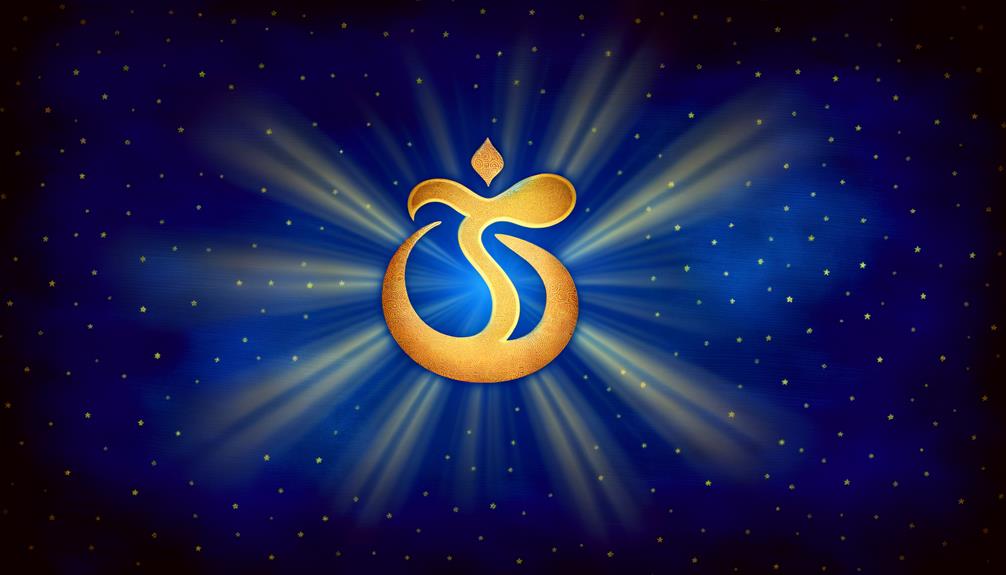
How does the Chai symbol, a simple yet profound representation of life, encapsulate the essence of Jewish identity and spirituality?
The Chai symbol, composed of the Hebrew letters Chet (ח) and Yud (י), translates to 'life' in English. This emblem is not merely a linguistic construct but a powerful cultural and religious icon that resonates deeply within Jewish tradition.
- Life and Vitality: Chai is emblematic of life's sanctity and the energy of existence.
- Numerical Significance: The letters of Chai add up to 18, a number symbolizing good fortune and longevity in Jewish numerology.
- Spiritual Resonance: The symbol underscores the Jewish emphasis on the value of life and ethical living.
- Cultural Presence: Frequently seen in jewelry and art, it serves as a constant reminder of spiritual and cultural heritage.
The Hamsa Hand
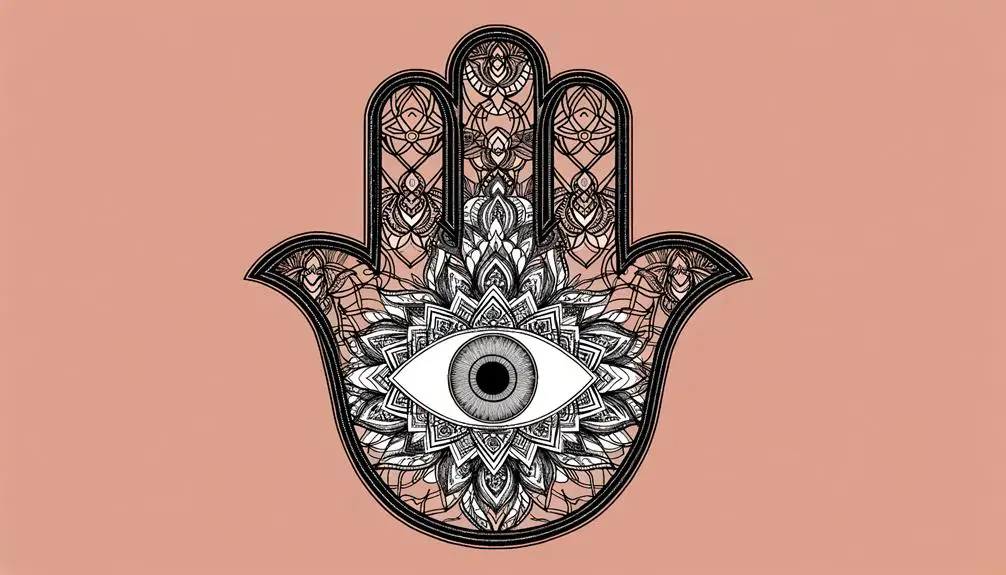
Just as the Chai symbol embodies the sanctity of life, the Hamsa Hand serves as a potent emblem of protection and divine blessing in Jewish culture. Often depicted as a stylized hand with an eye in the center, the Hamsa is believed to ward off the evil eye and invite divine favor. Its origins trace back to ancient Middle Eastern traditions, symbolizing God's hand safeguarding humanity.
| Aspect | Significance |
|---|---|
| Shape | Open hand with five fingers |
| Central Eye | Protection from the evil eye |
| Cultural Roots | Ancient Middle Eastern origins |
| Usage | Amulets, jewelry, wall hangings |
| Symbolism | Divine protection and blessing |
This sacred symbol integrates spirituality and cultural heritage, making it a revered icon in Jewish households.
The Torah Scroll
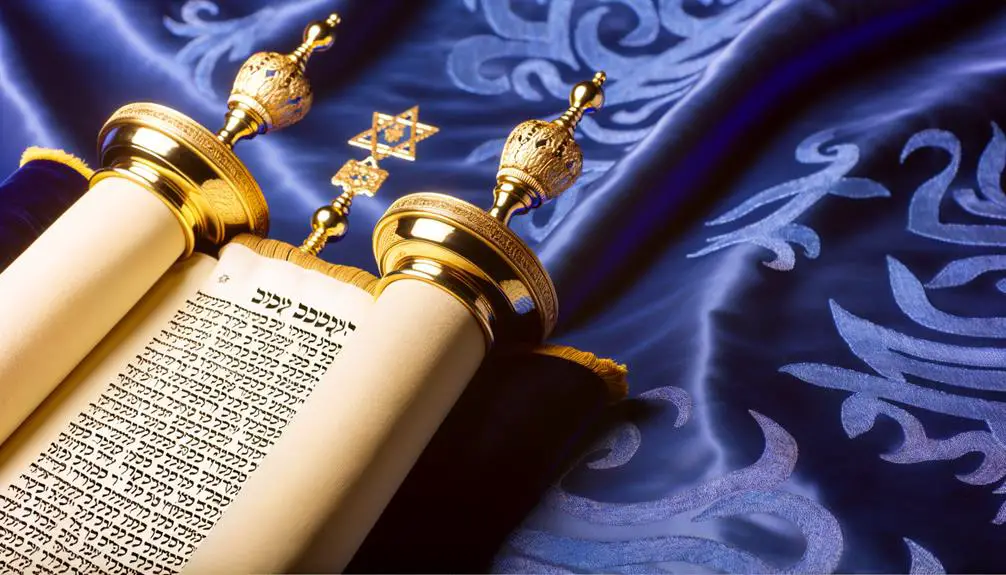
The Torah Scroll, central to Jewish worship and religious life, is a meticulously handwritten manuscript of the Five Books of Moses. Scribed on parchment using a quill and special ink, each Torah Scroll is a tribute to the Jewish people's reverence for their sacred texts.
The process of writing a Torah Scroll is a rigorous and sanctified task, requiring the scribe, or sofer, to follow strict guidelines.
- Sacred Texts: Contains Genesis, Exodus, Leviticus, Numbers, and Deuteronomy.
- Meticulous Craftsmanship: Written by hand with a quill on parchment.
- Ritual Significance: Integral to synagogue services and religious ceremonies.
- Symbol of Continuity: Represents the unbroken transmission of Jewish tradition.
The Torah Scroll embodies the enduring pact between the Jewish people and God.
The Tallit
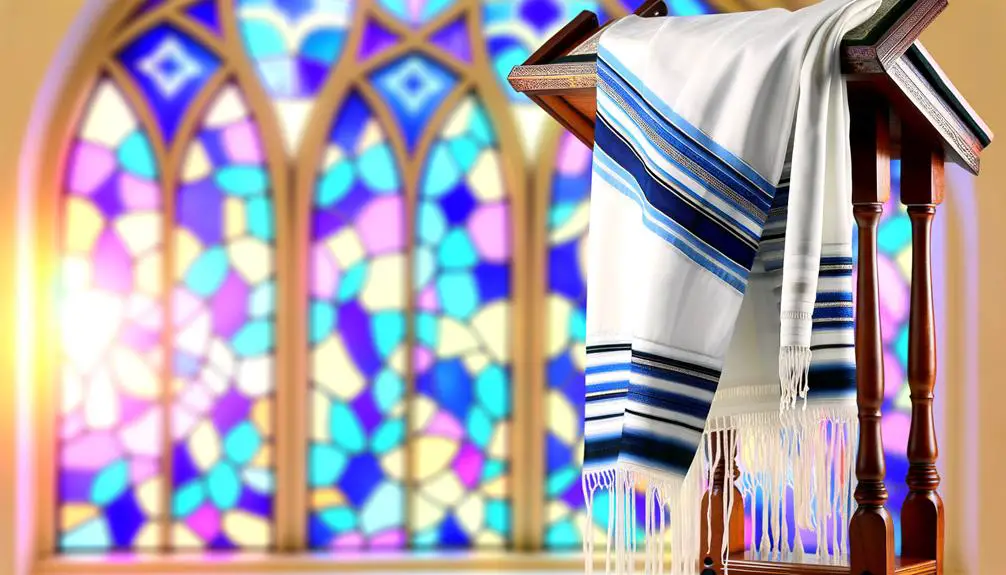
Worn during prayer and religious ceremonies, the tallit is a fringed garment that holds deep spiritual significance in Judaism. Traditionally made from wool or silk, the tallit serves as a physical reminder of the commandments.
The fringes, or tzitzit, attached to its four corners, are specifically instructed in the Torah (Numbers 15:38-39) to remind the wearer of their obligations to God.
The act of donning the tallit envelops an individual in a sacred space, fostering a direct and profound connection with the Divine. Often, the tallit is adorned with intricate patterns and inscriptions, further enhancing its sanctity.
It symbolizes the community's commitment to spiritual observance, encapsulating the essence of Jewish faith and tradition.
The Kippah

The Kippah, a small cap worn by Jewish men, holds profound religious significance as a symbol of reverence and recognition of a higher power.
Its cultural importance persists in contemporary society, reflecting both tradition and identity.
Varied in style and design, the Kippah embodies the diversity within the Jewish community while maintaining its sacred role.
Religious Significance Explained
A kippah, also known as a yarmulke, is a small, rounded skullcap that holds profound religious significance in Judaism. It serves as a constant, humble reminder of God's presence above, fostering a sense of reverence and humility in the wearer. The act of covering one's head is a symbolic acknowledgment of subservience to a higher moral authority.
- Divine Reminder: Wearing a kippah is a perpetual reminder of God's omnipresence.
- Symbol of Respect: It signifies respect and reverence during prayer and religious study.
- Cultural Continuity: The practice links individuals to centuries of Jewish tradition.
- Gender Norms: Traditionally worn by men, though some women also choose to wear it.
Thus, the kippah encapsulates faith, tradition, and humility in its simple form.
Cultural Importance Today
In contemporary society, the kippah remains a potent emblem of Jewish identity and religious observance. Revered for its profound spiritual symbolism, the kippah signifies reverence for the Divine and a commitment to Jewish traditions.
Its presence in public and private spheres serves as a visible symbol to the wearer's faith, fostering a sense of community and continuity within the Jewish diaspora. By covering the head, individuals acknowledge a higher authority above them, embodying humility and devotion.
This simple yet powerful garment transcends geographical boundaries, uniting Jews globally through shared heritage and religious expression. The kippah's enduring relevance today underscores its role in preserving and celebrating Jewish cultural and spiritual life.
Varieties and Styles
Numerous variations of kippah styles exist, each reflecting different facets of Jewish cultural and religious expression. The kippah, a symbol of reverence and humility before God, comes in various forms that resonate with diverse Jewish traditions and identities.
These head coverings, often crafted from different materials and adorned with unique designs, symbolize unity and respect within the Jewish community.
- Knitted Kippot: Often associated with Modern Orthodox Jews, these are colorful and hand-crafted.
- Black Velvet Kippot: Common among Haredi and some Orthodox communities, signifying a more traditional adherence.
- Suede Kippot: Popular in Conservative and Reform circles for their versatility and comfort.
- Decorative Kippot: Featuring intricate patterns and embroidery, used in celebratory settings like weddings and Bar Mitzvahs.
Each style encapsulates a profound spiritual significance, offering insight into the wearer's religious devotion and cultural background.
The Shofar
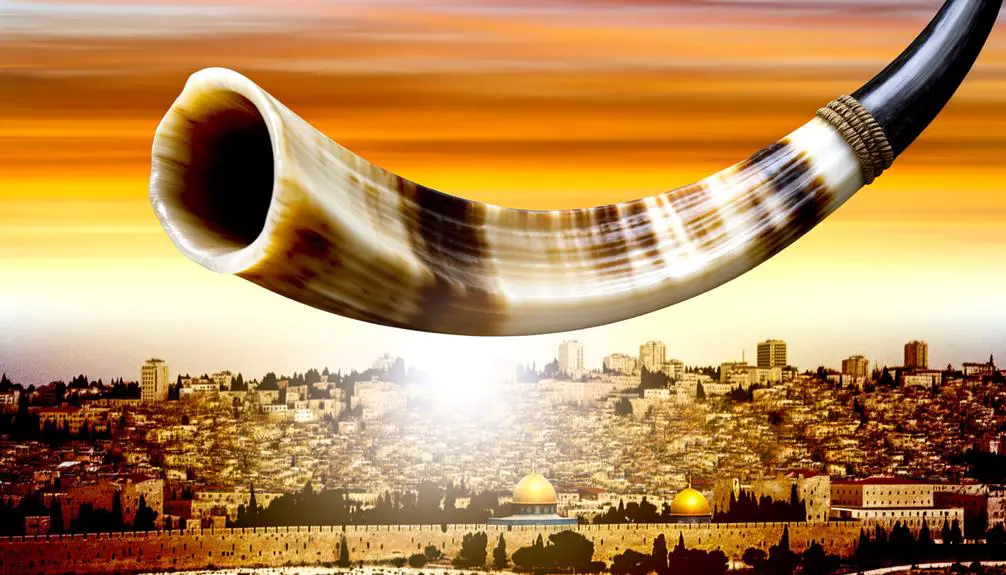
Reverberating through millennia, the sound of the shofar serves as a potent and sacred call to introspection and renewal within Judaism.
Traditionally crafted from a ram's horn, the shofar's blast is a central element of the High Holy Days, particularly Rosh Hashanah and Yom Kippur.
Its piercing tones are not merely ceremonial but are imbued with profound spiritual significance, symbolizing a direct communication with the Divine.
The shofar's call stirs the soul, reminding the faithful of the binding of Isaac and the covenantal relationship between God and the Jewish people.
Each note, whether tekiah, shevarim, or teruah, is a clarion call to awaken, repent, and embrace spiritual transformation, anchoring the community in a shared heritage and divine purpose.
The Dreidel

The dreidel, a four-sided spinning top, holds profound historical and spiritual significance within Judaism, particularly during the festival of Hanukkah. Each side bears a Hebrew letter—Nun, Gimel, Hei, and Shin—each imbued with deep meaning and collectively symbolizing the phrase 'A great miracle happened there.'
Exploring the dreidel's origins and its role in tradition reveals its enduring impact on Jewish culture and religious practice.
Historical Origins Explained
Steeped in rich cultural tradition, the dreidel's historical origins trace back to ancient customs that have transcended time and geography. The dreidel, a spinning top associated with Hanukkah, derives its roots from various gambling practices in ancient Europe. Jewish communities, under oppressive regimes prohibiting religious practice, ingeniously adapted these games to secretly study Torah and maintain their spiritual heritage.
This simple yet profound item embodies resilience and devotion, symbolizing the enduring spirit of Jewish faith through adversity.
Key historical insights include:
- Adaptation of European gambling games: Concealed religious study.
- Cultural resilience: Preservation of Jewish customs under duress.
- Symbolic representation: Proof of faith and perseverance.
- Evolution through diaspora: Unified Jewish identity across regions.
Examining these facets grants a deeper appreciation of the dreidel's enduring significance.
Symbols and Letters
Building on the historical context, the dreidel itself features four Hebrew letters—Nun, Gimel, Hei, and Shin—each laden with profound symbolic meaning. These letters form an acronym for 'Nes Gadol Hayah Sham,' translating to 'A great miracle happened there,' referencing the Hanukkah miracle of the oil lasting eight days.
Each letter also carries specific game instructions: Nun for 'nothing,' Gimel for 'all,' Hei for 'half,' and Shin for 'put in.' The dreidel hence embodies both a cultural memory and a didactic function, teaching about faith and resilience through playful engagement.
This integration of spiritual significance and communal activity underscores the rich, multifaceted nature of Jewish symbolism, inviting deeper contemplation and connection.
Dreidel in Tradition
Integral to Hanukkah celebrations, the dreidel serves as both a cherished artifact of Jewish tradition and a symbol of enduring faith. This four-sided spinning top, inscribed with Hebrew letters, encapsulates historical resilience and spiritual profundity.
Each letter—Nun, Gimel, Hei, and Shin—represents the phrase 'A great miracle happened there,' commemorating the Maccabean victory and the miracle of the Temple oil.
- Historical Significance: Reflects Jewish perseverance during Hellenistic oppression.
- Cultural Tradition: Enhances communal and familial bonds during Hanukkah.
- Educational Value: Teaches children about Jewish history and values.
- Spiritual Symbolism: Embodies hope and divine intervention.
The dreidel's presence in Hanukkah festivities perpetuates a legacy of faith, unity, and cultural identity.
Conclusion
The symbols of Judaism each carry profound spiritual and historical significance, serving as tangible representations of faith, culture, and tradition.
From the Star of David to the Dreidel, these symbols encapsulate the essence of Jewish identity and heritage.
What deeper connection could exist than one that links both past and present through such enduring emblems?
Through these symbols, the rich tapestry of Judaism continues to inspire and guide adherents, fostering a timeless sense of unity and purpose.


